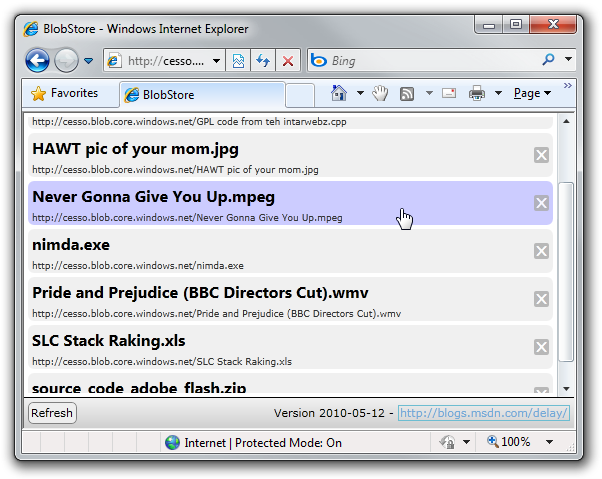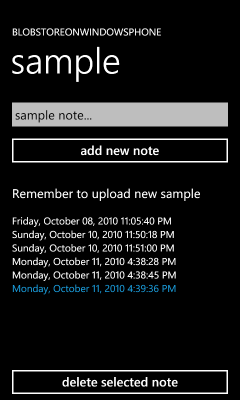Is that a BLOB in your pocket, or are you just happy to see me? [Silverlight REST-based Azure/S3 BLOB API updated to run on Windows Phone 7!]
It was about five months ago that I blogged about BlobStore, a simple Silverlight 4 REST-based cloud-oriented file management app for Azure and S3. I pitched it like this:
It's a small, lightweight Silverlight 4 application that acts as a basic front-end for the Windows Azure Simple Data Storage and the Amazon Simple Storage Service (S3)! Just run the
BlobStoreapp, point it at a properly provisioned Azure or S3 account (see below for details on provisioning), and all of a sudden sharing files with yourself and others becomes as simple as dragging and dropping them!...
Included with every code download is a free REST wrapper for basic Azure and S3 blob access that handles all the tricky Authorization header details for you. It's almost guaranteed to make your next Azure/S3 application a snap to develop and a wild success in the marketplace.

Disclaimer: None of the file names above is accurate. :)
I know people have incorporated my REST API wrapper code (BlobStoreApi.cs) into their Silverlight projects, so it wasn't too surprising when I heard that some of you want the same functionality for your Windows Phone 7 applications. While you might expect the existing code to work as-is, there's a catch: Windows Phone 7's version of the Silverlight framework doesn't support the HttpWebRequest.AllowWriteStreamBuffering or WebRequest.ContentLength properties - and both are used by the original BlobStoreApi.cs implementation...
Fortunately, the lack of AllowWriteStreamBuffering isn't a big deal because it's used in only one place and can be commented-out with no loss of functionality (assuming the default behavior of buffering the entire upload doesn't bother you). However, the lack of ContentLength is a little more problematic because its use is more tightly integrated with the rest of code. So it seemed worthwhile for me to update BlobStoreApi.cs for Windows Phone 7 - and it turned out to be fairly simple to remove ContentLength for Windows Phone 7 without changing the existing behavior for Silverlight 4 and desktop .NET.
Because the original file management sample application didn't translate very well to the phone, I dashed off a quick "note taking" sample instead:

The way the new sample works is that the user can type short notes in a text box and then hit the "add" button to upload them to their pre-configured Azure/S3 account as BLOBs with the blob name being the current DateTime.Now.Ticks value and its content being the text of the note. All available notes are listed by date of creation; their text contents are downloaded on demand and shown to the user when selected. Any note can be deleted by tapping it and hitting the "delete" button.
It's a simple application, but it shows off the list/get/put/delete functionality that BlobStoreApi implements for Azure, S3, and IsolatedStorage (the last existing mainly for test purposes). During calls to the BLOB service, the sample application shows a simple progress screen informing the user of the ongoing transaction. (Of course, IsolatedStorage is very fast, so the progress screen is little more than a flicker by default - it's more meaningful for Azure/S3 web access.)
The complete implementation can be found in BlobStore\BlobStoreApi.cs and compiles/runs on the .NET, Silverlight, and Windows Phone 7 platforms. I encourage readers to use this code to create way more compelling applications than my samples! :)
Note: By default, the Windows Phone sample uses IsolatedStorage because I don't want to publish the keys to my Azure/S3 accounts. :) If you want to try it with your own account(s), just openMainPage.xaml.cs, uncomment the relevant line below, and add the missing information:// TODO: Switch to AzureBlobStoreClient or S3BlobStoreClient after entering your connection information private readonly BlobStoreClient _client = new IsolatedStorageBlobStoreClient(); //private readonly BlobStoreClient _client = new AzureBlobStoreClient("Account Name", "Access Key"); //private readonly BlobStoreClient _client = new S3BlobStoreClient("Access Key ID", "Secret Access Key", "Bucket Name");Aside: Don't forget to provision your account first; see the notes here for more information!